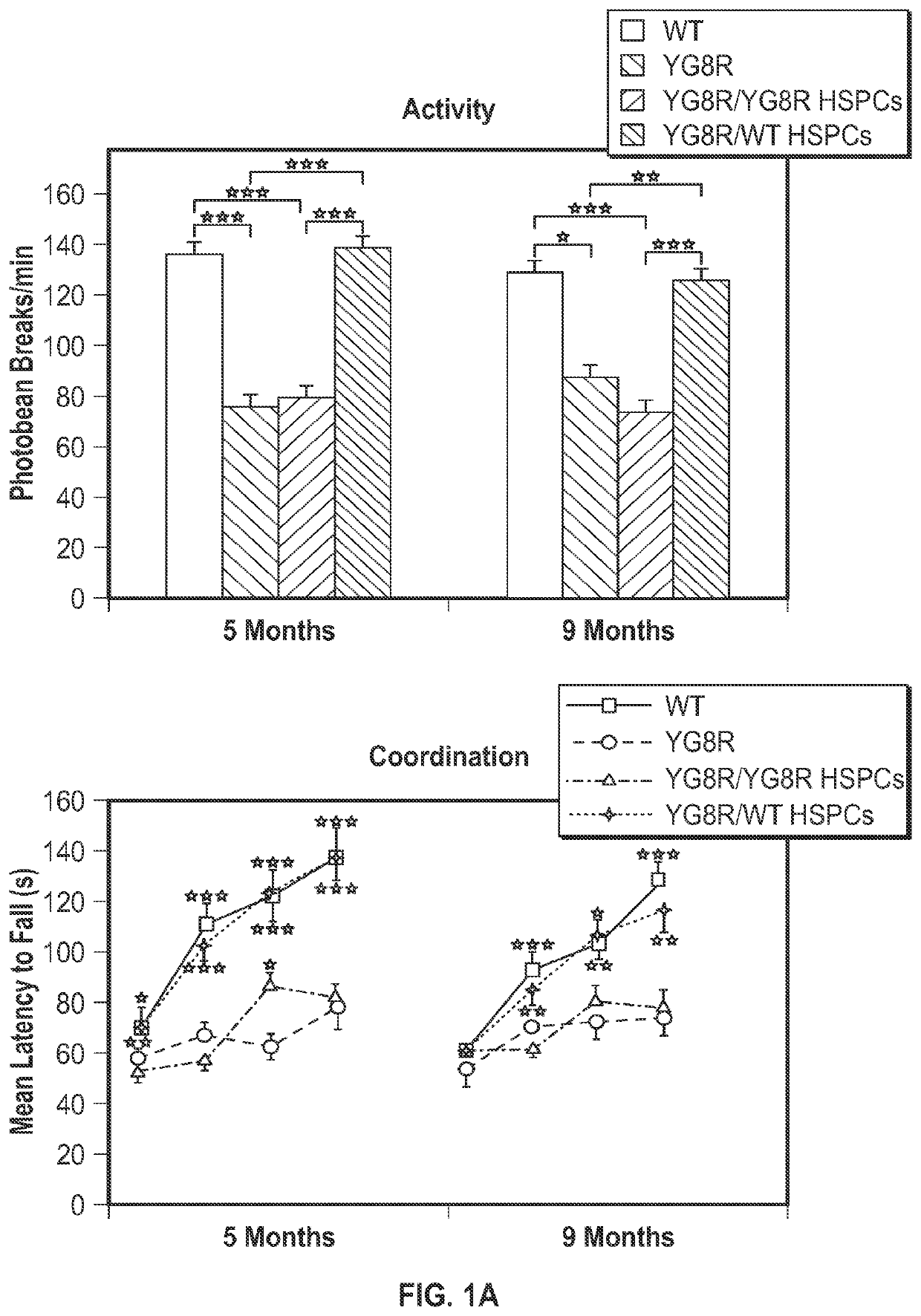Methods of treating mitochondrial disorders
a technology of mitochondrial disorders and methods, applied in the field of mitochondrial diseases, can solve problems such as no known cures or preventative measures
- Summary
- Abstract
- Description
- Claims
- Application Information
AI Technical Summary
Benefits of technology
Problems solved by technology
Method used
Image
Examples
example 1
Treatment of FRDA Mouse Model Using HPSC Transplantation
[0088]Systemic transplantation of wild-type HSPCs prevents onset of locomotor deficits in YG8R mice. To assess the effects of HSPC transplantation on FRDA, the YG8R mouse model expressing the mutant human FXN gene containing 280 GAA repeats (SEQ ID NO: 14), and lacking endogenous murine frataxin, mfxn− / − hFXN+ was used. Lethally irradiated 2 month-old YG8R mice were transplanted with wild-type (WT) GFP-expressing HSPCs (n=13) and donor-derived blood cell engraftment ranged from 35 to 96% as determined by flow cytometry. Mice are sacrificed for analysis at 7 months post-transplantation, i.e., at 9 months of age. As controls, WT littermates (n=17), untreated YG8R (n=4) or lethally irradiated YG8R mice transplanted with mfxn− / − hFXN+ HSPCs (n=5) were analyzed. All the mice were assessed by behavioral testing at 5 months old (3 months post-transplant), and 8 WT, 4 YG8R (3 untreated and 1 transplanted with mfxn− / − hFXN+ HSPCs) and 3...
example 2
Materials and Methods
[0104]Animals. YG8R mice with a deletion of murine Fxn gene (mFxn) and expressing mutant human FX gene (hFXN) containing 190+90 GAA repeat expansion were generated in a C57BL / 6J background as previously described (Al-Mahdawi, et al., GAA repeat instability in Friedreich ataxia YAC transgenic mice. Genomics 84, 301-310 (2004); Al-Mahdawi, et al., GAA repeat expansion mutation mouse models of Friedreich ataxia exhibit oxidative stress leading to progressive neuronal and cardiac pathology. Genomics 88, 580-590 (2006), both of which are incorporated herein by reference). Breeding pairs consisted of females heterozygous for Fxn and males heterozygous for Fxn and hemizygous for FXA (B6.Cg-FxntmlMkn Tg(FXN)YG8Pook / J), and were purchased from Jackson Laboratory (Bar Harbor, Me.). YG8R mice and wild-type (WT) mice used as controls for these studies were obtained from these breeders. Genotyping was performed using the following primers:
mfxn-F:(SEQ ID NO: 5)5′-CTTCCCTCTACC...
PUM
| Property | Measurement | Unit |
|---|---|---|
| density | aaaaa | aaaaa |
| density | aaaaa | aaaaa |
| density | aaaaa | aaaaa |
Abstract
Description
Claims
Application Information
 Login to View More
Login to View More - R&D
- Intellectual Property
- Life Sciences
- Materials
- Tech Scout
- Unparalleled Data Quality
- Higher Quality Content
- 60% Fewer Hallucinations
Browse by: Latest US Patents, China's latest patents, Technical Efficacy Thesaurus, Application Domain, Technology Topic, Popular Technical Reports.
© 2025 PatSnap. All rights reserved.Legal|Privacy policy|Modern Slavery Act Transparency Statement|Sitemap|About US| Contact US: help@patsnap.com



